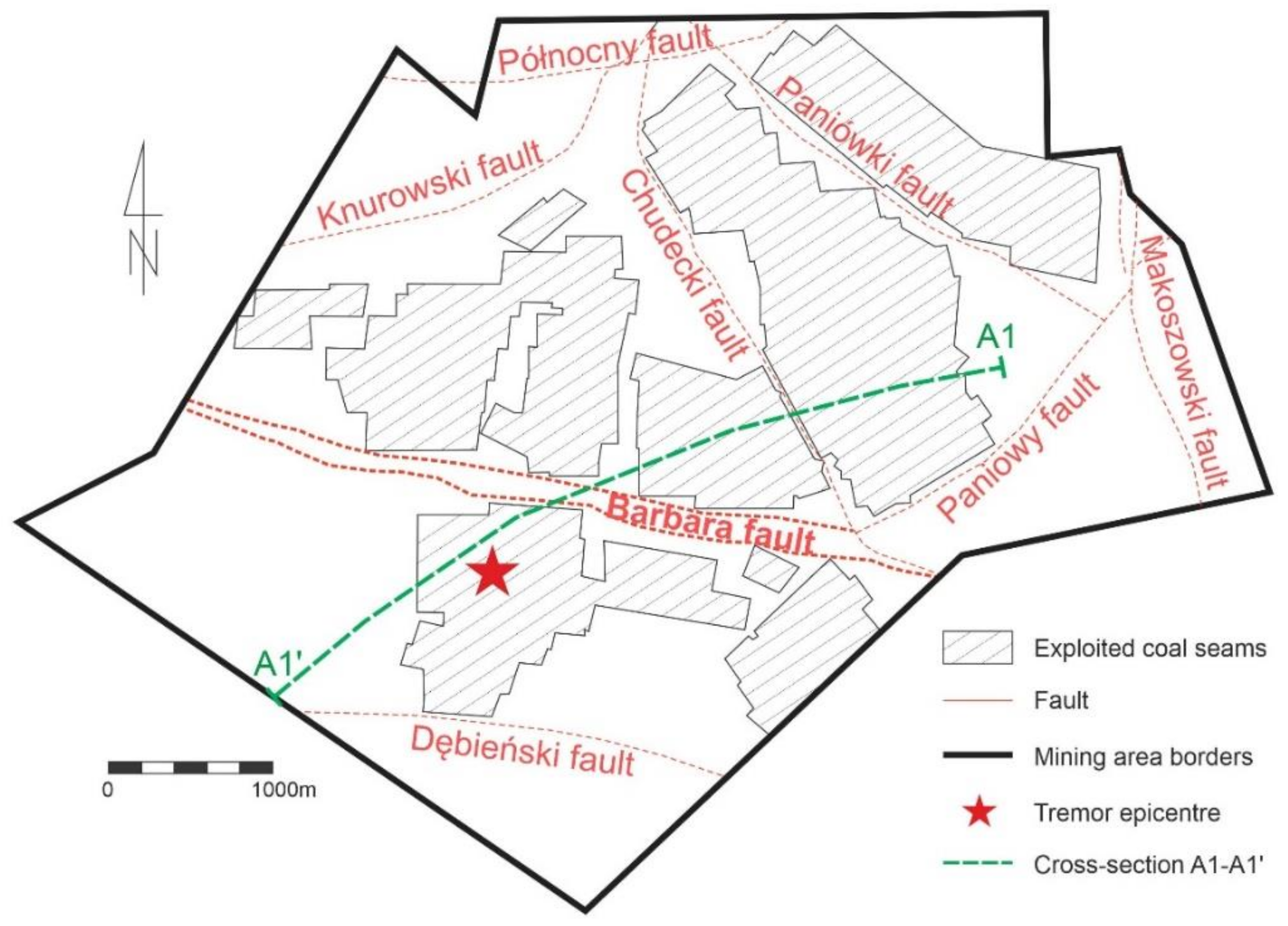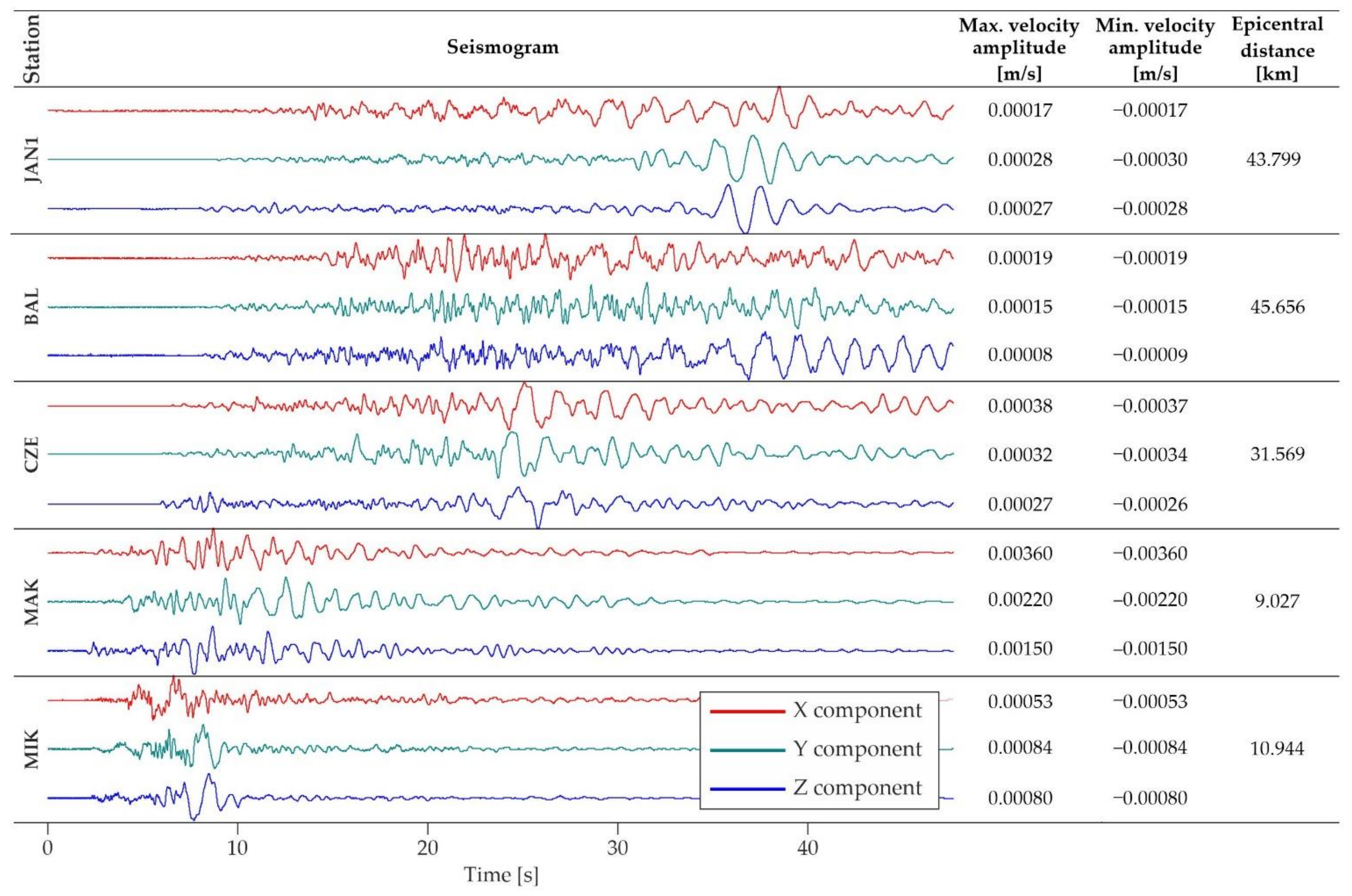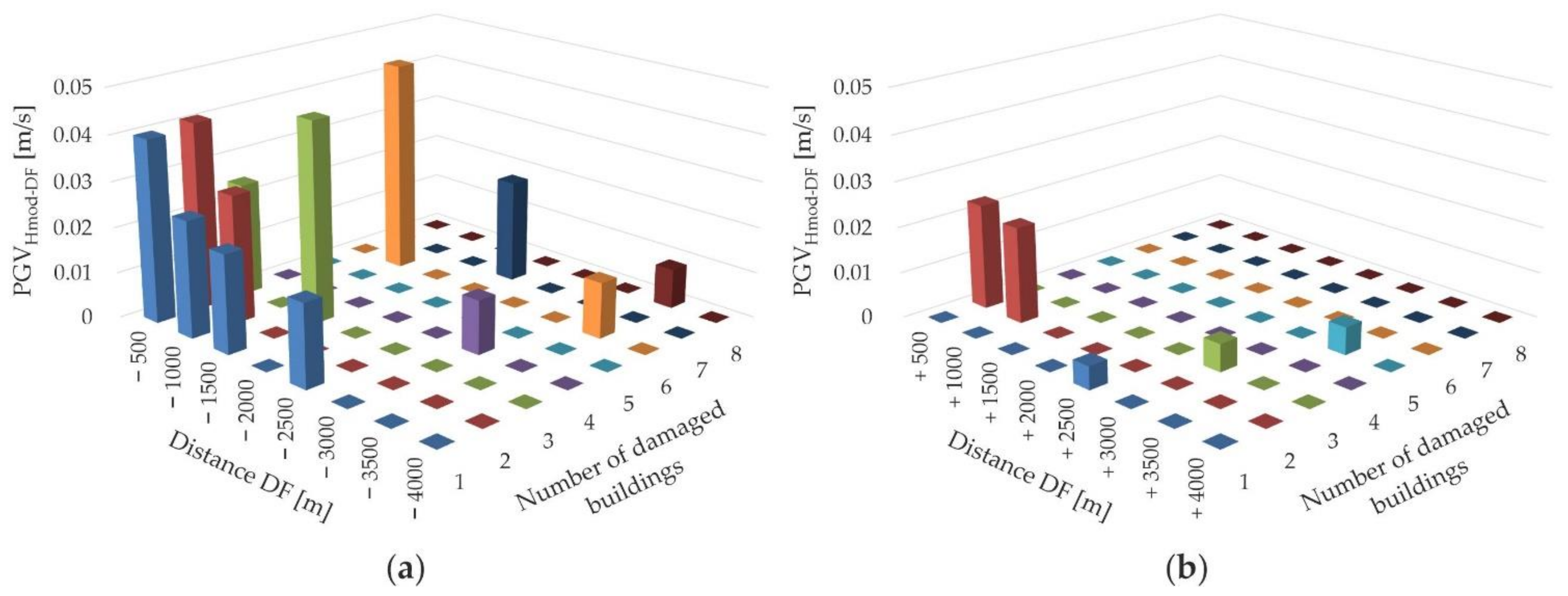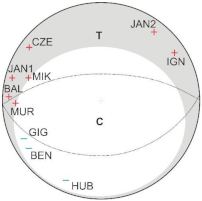The Impact of High-Energy Mining-Induced Tremor in a Fault Zone on Damage to Buildings
Abstract
1. Introduction
2. Methods and Data
- Seismic source parameters—physical quantities describing the focal mechanism;
- Structure and properties of rock mass in the way of propagation of the seismic waves;
- Seismological properties of the loosened overburden at the vibration reception station (site effect), determined by the vibration amplification factor;
- The types and properties of buildings threatened by seismic energy.
2.1. Focal Mechanism
- uk are the displacement amplitude measurements of the first maximum of the P-wave;
- Mij is a jth component of the vector of moment tensor terms (Mxx, Myy, Mzz, Mxy, Mxz, Myx);
- Gij is a matrix of appropriate Green’s function in a whole homogeneous space.
2.2. Ground Vibrations
3. Geological and Mining Conditions
4. Results
4.1. Focal Mechanism
4.2. Ground Vibrations
4.3. Damage to the Buildings on the Ground Surface
5. Results
6. Conclusions
- The high-energy tremor, which occurred on 8 November 2018, had a regional and tectonic character. The stress generated by the current mining was only a trigger reducing the elastic energy accumulated in the Barbara fault zone. This elastic energy accumulation resulted from historic exploitation in a large area from both sides of the fault zone;
- The tremor was characterised by a normal slip mechanism with 62% of the shear component. The location and orientation of the focal fracture plane correlate with the orientation of the hanging wall of the Barbara fault zone. The orientation of the fracture plane means that the greatest radiation of seismic energy occurred in the south and west-east directions because this radiation is perpendicular and parallel to the plane in focus;
- The seismic energy propagated in most in the south and west-east directions from the tremor focus has been confirmed with the location of damage to buildings on the ground surface. To the south of the Barbara normal fault, the number of cases of damage was greater than to the north of the fault. In the northern part, the number of instances of damage was 14 (19%), and in the southern part, it was 58 (81%). Another reason for the different cases of damages from both sides of the fault was the seismic energy attenuation by the rather wide Barbara fault zone of several dozen meters;
- The most serious cases of damage to buildings were located at a distance of up to about 1200 m from the Barbara fault. This is in line with previous studies [6] on the geological conditions of the Upper Silesian Coal Basin.
Author Contributions
Funding
Data Availability Statement
Acknowledgments
Conflicts of Interest
References
- Li, T.; Cai, M.F.; Cai, M. A Review of Mining-Induced Seismicity in China. Int. J. Rock Mech. Min. 2007, 44, 1149–1171. [Google Scholar] [CrossRef]
- Chodacki, J. New Ground Motion Prediction Equation for Peak Ground Velocity and Duration of Ground Motion for Mining Tremors in Upper Silesia. Acta Geophys. 2016, 64, 2449–2470. [Google Scholar] [CrossRef]
- Bańka, P.; Lier, E.; Fernández, M.M.; Chmiela, A.; Muñiz, Z.F.; Sanchez, A.B. Directional Attenuation Relationship for Ground Vibrations Induced by Mine Tremors. J. Min. Sci. 2020, 56, 236–245. [Google Scholar] [CrossRef]
- Dubiński, J.; Pilecki, Z.; Zuberek, W.M. (Eds.) Badania Geofizyczne W Kopalniach [Geophysical Surveying in Mines]; IGSMiE PAN: Cracow, Poland, 2001. (In Polish) [Google Scholar]
- Mutke, G.; Chodacki, J.; Muszyński, L.; Kremers, S.; Fritschen, R. Mining Seismic Instrumental Intensity Scale MSIIS-15 Verification in Coal Basins. In Proceedings of the 5th International Symposium: Mineral Resources and Mine Development, Aachen, Germany, 27–28 May 2015; RWTH Aachen University: Aachen, Germany; pp. 551–560. [Google Scholar]
- Pilecka, E.; Stec, K.; Szermer-Zaucha, R. The influence of the Kłodnica fault tectonic zone on the degree of damage to buildings resulting from high magnitude tremors. Tech. Trans. 2017, 7, 53–64. [Google Scholar] [CrossRef][Green Version]
- Gibowicz, S.; Kijko, A. An Introduction to Mining Seismology; Academic Press Inc.: London, UK, 1994. [Google Scholar]
- Gibowicz, S.J. Seismicity induced by mining: Recent research. Adv. Geophys. 2009, 51, 1–563. [Google Scholar] [CrossRef]
- Marcak, H.; Pilecki, Z. Assessment of the subsidence ratio be based on seismic noise measurements in mining terrain. Arch. Min. Sci. 2019, 64, 197–212. [Google Scholar] [CrossRef]
- Dubiński, J.; Stec, K.; Mutke, G. Relationship between the focal mechanism of magnitude ML 3.3 seismic event induced by mining and distribution of peak ground velocity. In Proceedings of the 3rd International Conference on Applied Geophysics, Gniew, Poland, 21–23 June 2017; Volume 24. [Google Scholar] [CrossRef]
- Pilecki, Z. Dynamic Analysis of Mining Tremor Impact an Excavation in a Coal Mine. In FLAC Numerical Modeling in Geomechanics; Hart, D., Ed.; August Aimé Balkema: Rotterdam, The Netherlands, 1999; pp. 397–400. [Google Scholar]
- Wang, G.; Gong, S.; Li, Z.; Dou, L.; Cai, W.; Mao, Y. Evolution of stress concentration and energy release before rock bursts: Two case studies from Xingan Coal mine Hegang, China. Rock Mech. Rock Eng. 2016, 49, 3393–3401. [Google Scholar] [CrossRef]
- Kijko, A.; Drzęźla, B.; Stankiewicz, T. Bimodal character of extremal seismic events in Polish mines. Acta Geophys. 1987, 35, 1157–1168. [Google Scholar]
- European Committee for Standardization. Norm PN EN 1998-1:2005: Eurocode 8: Design Provisions for Earthquake Resistance of Structures–Part 1: General Rules, Seismic Actions and General Requirements for Structures; European Committee for Standardization: Brussels, Belgium, 2004. [Google Scholar]
- Cianciara, B.; Marcak, H. Models of the Spatial Distribution of Seismic Acceleration Caused by Mining Tremors. In Proceedings of the IXth Symposium on Seismic Impacts on Constructions, Cracow University of Technology, Kraków, Poland, 23–24 November 2000; pp. 183–193. (In Polish). [Google Scholar]
- Głowacka, E. Application of the extracted deposit volume as a measure of deformation for the seismic hazard evaluation in mines. Tectonophysics 1992, 202, 285–290. [Google Scholar] [CrossRef]
- Szreder, Z.; Pilecki, Z.; Kłosiński, J. Effectiveness of recognition of exploitation edge influence with the help of profiling of attenuation and velocity of seismic wave. Gospod. Surowcami Min. 2008, 24, 215–226. [Google Scholar]
- Czarny, R.; Marcak, H.; Nakata, N.; Pilecki, Z.; Isakow, Z. Monitoring velocity changes caused by underground coal mining using seismic noise. Pure. Appl. Geophys. 2016, 173, 1907–1916. [Google Scholar] [CrossRef]
- Czarny, R.; Pilecki, Z.; Nakata, N.; Pilecka, E.; Krawiec, K.; Harba, P.; Barnaś, M. 3D S-wave velocity imaging of a subsurface disturbed by mining using ambient seismic noise. Eng. Geol. 2019, 251, 115–127. [Google Scholar] [CrossRef]
- Dubiński, J.; Bukowska, M.; Stec, K. Geomechanical and Tectonophysical Conditions of Mining-Induced Seismicity in the Upper Silesian Coal Basin in Poland: A Case Study. Arch. Min. Sci. 2019, 64, 163–180. [Google Scholar] [CrossRef]
- Chlebowski, D.; Burtan, Z. Geophysical and analytical determination of overstressed zones in exploited coal seam: A case study. Acta Geophys. 2021, 69, 701–710. [Google Scholar] [CrossRef]
- Stec, K. Characteristics of seismic activity of the Upper Silesian coal basin in Poland. Geophys. J. Int. 2007, 168, 757–768. [Google Scholar] [CrossRef]
- Aki, K.; Richards, P.G. Quantitative Seismology: Theory and Methods; Freeman and Co.: San Francisco, CA, USA, 1980; Volume 1–2. [Google Scholar]
- Boore, D.M.; Joyner, W.B. The Empirical Prediction of Ground Motion. Bull. Seismol. Soc. Am. 1982, 72, 43–60. [Google Scholar] [CrossRef]
- Kwiatek, G.; Martínez-Garzón, P.; Bohnhoff, M. HybridMT: A MATLAB/shell environment package for seismic moment tensor inversion and refinement. Seismol. Res. Lett. 2016, 87, 964–976. [Google Scholar] [CrossRef]
- Bard, P.Y.; Bouchon, M. The seismic response of sediment-filled valleys. Part 2. The case of incident P and SV waves. Bull. Seismol. Soc. Am. 1980, 70, 1921–1941. [Google Scholar] [CrossRef]
- Pitilakis, K. Site Effects, in Recent Advances in Earthquake Geological Engineering and Microzonation; Ansal, A., Ed.; Kluwer Academic Publishers: Dordrecht, The Netherlands, 2004. [Google Scholar]
- Gatmiri, B.; Arson, C. Seismic site effects by an optimised 2D BE/FE method II. Quantification of site effects in two-dimensional sedimentary valleys. Soil Dyn. Earthq. Eng. 2008, 28, 646–661. [Google Scholar] [CrossRef]
- Moczo, P.; Kristek, J.; Bard, P.Y.; Stripajová, S.; Hollender, F.; Chovanová, Z.; Kristeková, M.; Sicilia, D. Key structural parameters affecting earthquake ground motion in 2D and 3D sedimentary structures. Bull. Earthq. Eng. 2018, 16, 2421–2450. [Google Scholar] [CrossRef]
- Falcone, G.; Boldini, D.; Amorosi, A. Site response analysis of an urban area: A multi-dimensional and non-linear approach. Soil Dyn. Earthq. Eng. 2018, 109, 33–45. [Google Scholar] [CrossRef]
- Falcone, G.; Acunzo, G.; Mendicelli, A.; Mori, F.; Naso, G.; Peronace, E.; Porchia, A.; Romagnoli, G.; Tarquini, E.; Moscatelli, M. Seismic amplification maps of Italy based on site-specific microzonation dataset and one-dimensional numerical approach. Eng. Geol. 2021, 289, 106170. [Google Scholar] [CrossRef]
- Dolce, M.; Prota, A.; Borzi, B.; da Porto, F.; Lagomarsino, S.; Magenes, G.; Moroni, C.; Penna, A.; Polese, M.; Speranza, E.; et al. Seismic risk assessment of residential buildings in Italy. Bull. Earthq. Eng. 2020, 19, 2999–3032. [Google Scholar] [CrossRef]
- Luo, Y.; Fan, X.; Huang, R.; Wang, Y.; Yunus, A.P.; Havenith, H.B. Topographic and near-surface stratigraphic amplification of the seismic response of a mountain slope revealed by field monitoring and numerical simulations. Eng. Geol. 2020, 271, 105607. [Google Scholar] [CrossRef]
- Fayjaloun, R.; Negulescu, C.; Roullé, A.; Auclair, S.; Gehl, P.; Faravelli, M.; Abrahamczyk, L.; Petrovčič, S.; Martinez-Frias, J. Sensitivity of Earthquake Damage Estimation to the Input Data (Soil Characterization Maps and Building Exposure): Case Study in the Luchon Valley, France. Geosciences 2021, 11, 249. [Google Scholar] [CrossRef]
- Chodacki, J. Simulation of ground motion in a Polish coal mine using the spectral-element method. J. Seismol. 2020, 24, 363–373. [Google Scholar] [CrossRef]
- Del Gaudio, V.; Coccia, S.; Wasowski, J.; Gallipoli, M.R.; Mucciarelli, M. Detection of directivity in seismic site response from microtremor spectral analysis. Nat. Hazard. Earth Syst. 2008, 8, 751–762. [Google Scholar] [CrossRef]
- Panzera, F.; Lombardo, G.; Imposa, S.; Grassi, S.; Gresta, S.; Catalano, S.; Romagnoli, G.; Tortorici, G.; Patti, F.; Di Maio, E. Correlation between earthquake damage and seismic site effects: The study case of Lentini and Carlentini, Italy. Eng. Geol. 2018, 240, 149–162. [Google Scholar] [CrossRef]
- Mori, F.; Gena, A.; Mendicelli, A.; Naso, G.; Spina, D. Seismic emergency system evaluation: The role of seismic hazard and local effects. Eng. Geol. 2020, 270, 105587. [Google Scholar] [CrossRef]









| IMSIIS | PGVHmax for short duration (tHV ≤ 1.5 s) [m/s] | PGVHmax for long duration (tHV > 1.5 s) [m/s] | Perceived Shaking | Potential Damage |
|---|---|---|---|---|
| I | <0.005 | <0.005 | Not felt or weakly felt. | None |
| II | 0.005–0.020 | 0.005–0.010 | Felt indoors by many people, outdoors by few. Dishes rattle, hanging objects begin to sway. | None |
| III | 0.020–0.035 | 0.010–0.025 | Felt strongly indoors by many people, weak rocking of the whole building. Open windows and doors may close. | Intensification of existing damage |
| IV | 0.035–0.050 | 0.025–0.040 | Felt strongly by most people. Many people are frightened and run outdoors. The furniture may shift, the whole building rocks. | Damage to decorative elements |
| V | 0.050–0.070 | 0.040–0.060 | Felt very strongly by most people. Most people are frightened and try to run outdoors. A few people lose their balance. A large number of objects fall from shelves. | Slight single structural damage |
| Nodal Plane A, B | Stress Axes C, T | Tensor Component, % | Normal Slip Mechanism | ||||
|---|---|---|---|---|---|---|---|
| A Φ°/δ° λ° | B Φ°/δ° λ° | C Φ°/δ° | T Φ°/δ° | ISO | CLVD | DC |  |
| 269/60–89 | 86/31–93 | 184/75 | 358/14 | 18 | 20 | 62 | |
| Seismic Station | Epicentral Distance, [m] | Amplification Factor Wf [-] | PGV, [m/s] | PGVHmod, [m/s] | Duration Time tHT, [s] |
|---|---|---|---|---|---|
| ST 1- AMAX | 1816 | 2.4 | 0.0206 | 0.011 | 9.20 |
| ST 2- AMAX | 2574 | 2.4 | 0.0092 | 0.0071 | 8.46 |
| ST 3- AMAX | 2360 | 2.6 | 0.0040 | 0.0079 | 3.88 |
| No. | Nd 1 | Locality | Description of the damage | Distance from the Barbara fault +/−DF 2,3, [m] | PGVHmod-D [m/s] | Epicentral distance [m] | IMSIIS 4 |
|---|---|---|---|---|---|---|---|
| 1. | 1 | Gierałtowice | scratches | +4500 | 0.003 | 5332 | 0 |
| 2. | 2 | Gierałtowice | cracks | +3450 | 0.006 | 4870 | I |
| 3. | Gierałtowice | facade cracks | +3450 | 0.006 | 4870 | I | |
| 4. | Gierałtowice | unsealing of the smoke duct, scratches | +3450 | 0.006 | 4870 | I | |
| 5. | Gierałtowice | damage to the chimney, cracks and scratches | +3450 | 0.006 | 4870 | I | |
| 6. | Gierałtowice | scratches | +3450 | 0.006 | 4870 | I | |
| 7. | 7 | Gierałtowice | scratches on the garage wall | +2600 | 0.006 | 5050 | I |
| 8. | 8 | Gierałtowice | scratches | +2650 | 0.006 | 3557 | I |
| 9. | Gierałtowice | scratches | +2600 | 0.006 | 3517 | I | |
| 10. | 10 | Gierałtowice | scratches | +2300 | 0.005 | 3514 | I |
| 11. | 11 | Ornontowice | broken lintels above the window and scratches | +350 | 0.023 | 1367 | II |
| 12. | 12 | Ornontowice | farm building crack | +700 | 0.021 | 1629 | II |
| 13. | 13 | Ornontowice | photo frame broken | +500 | 0.023 | 1364 | II |
| 14. | 14 | Ornontowice | scratches and cracks | +650 | 0.021 | 1597 | II |
| 15. | 15 | Ornontowice | slight widening of damage that occurred previously | −1000 | 0.047 | 362 | IV |
| 16. | Ornontowice | scratches | −1000 | 0.047 | 359 | IV | |
| 17. | Ornontowice | scratches and cracks | −1150 | 0.048 | 391 | IV | |
| 18. | 16 | Ornontowice | slight widening of damage that occurred previously | −900 | 0.044 | 489 | IV |
| 19. | 17 | Ornontowice | cracks | −1000 | 0.040 | 623 | IV |
| 20. | 18 | Ornontowice | scratches and cracks | −800 | 0.030 | 863 | III |
| 21. | 19 | Ornontowice | damage repaired during the last renovation (scratches and cracks) reappeared | −250 | 0.027 | 958 | III |
| 22. | 20 | Ornontowice | cracks, overturning of a fragment of the firewall | −350 | 0.041 | 452 | IV |
| 23. | Ornontowice | cracks in the walls, broken glassware | −350 | 0.041 | 452 | IV | |
| 24. | 22. | Ornontowice | damage to the water system and water leakage | −500 | 0.033 | 745 | III |
| 25. | 23. | Ornontowice | scratches | −750 | 0.047 | 242 | IV |
| 26. | Ornontowice | scratches | −950 | 0.048 | 214 | IV | |
| 27. | 26. | Ornontowice | scratches | −1200 | 0.043 | 601 | IV |
| 28. | Ornontowice | scratches, luxfer rupture | −1200 | 0.041 | 628 | IV | |
| 29. | 27 | Ornontowice | scratches | −300 | 0.025 | 1103 | II |
| 30. | 28 | Ornontowice | scratches | −300 | 0.022 | 1465 | II |
| 31. | 29 | Ornontowice | scratches | −700 | 0.046 | 370 | IV |
| 32. | 30 | Ornontowice | scratches and detachment of a fragment of the glazing | −700 | 0.026 | 1074 | III |
| 33. | 33 | Ornontowice | separating the vestibule from the rest of the building | −2000 | 0.021 | 1753 | II |
| 34. | 34 | Ornontowice | cracks in the ceiling, along steel beams and walls | −1850 | 0.019 | 2031 | II |
| 35. | 35 | Ornontowice | scratches and cracks | −1650 | 0.028 | 1140 | III |
| 36. | 36 | Dębieńsko | cracks | −1950 | 0.018 | 2037 | II |
| 37. | Dębieńsko | cracks in the chimney and walls | −2000 | 0.017 | 2081 | II | |
| 38. | Dębieńsko | scratches | −2000 | 0.018 | 2051 | II | |
| 39. | 37. | Dębieńsko | scratches and cracks | −1750 | 0.018 | 1874 | II |
| 40. | Dębieńsko | scratches | −1700 | 0.019 | 1796 | II | |
| 41. | 39 | Ornontowice | wall scratches, cracks in ceramic tiles | −2000 | 0.018 | 2006 | II |
| 42. | 42 | Ornontowice | scratches | −1950 | 0.028 | 1165 | III |
| 43. | Ornontowice | scratches | −1950 | 0.027 | 1170 | III | |
| 44. | Ornontowice | scratches and cracks | −1950 | 0.027 | 1145 | III | |
| 45. | Ornontowice | scratches, plaster losses | −1950 | 0.027 | 1145 | III | |
| 46. | 44 | Ornontowice | scratches | −1800 | 0.029 | 1071 | III |
| 47. | 45 | Ornontowice | scratches | −1250 | 0.023 | 1590 | II |
| 48. | 46 | Ornontowice | scratches and cracks | −1200 | 0.020 | 1996 | II |
| 49. | 47 | Mikołów | scratches that have formed before | −1000 | 0.011 | 2567 | II |
| 50. | 48 | Dębieńsko | scratches, cracks, chimney damage | −2300 | 0.018 | 2049 | II |
| 51. | 51 | Dębieńsko | minor scratches | −2950 | 0.013 | 2640 | II |
| 52. | 54 | Dębieńsko | facade crack | −3100 | 0.008 | 4370 | I |
| 53. | 55 | Dębieńsko | facade crack, separation of the stairs | −3250 | 0.009 | 3624 | I |
| 54. | Dębieńsko | scratches and cracks | −3250 | 0.009 | 3609 | I | |
| 55. | 56 | Dębieńsko | scratches and cracks | −3250 | 0.010 | 3283 | II |
| 56. | 57 | Dębieńsko | scratches and cracks | −3200 | 0.009 | 3983 | I |
| 57. | 58 | Ornontowice | enlargement of existing scratch | −2900 | 0.010 | 2068 | II |
| 58. | 59 | Ornontowice | enlargement of existing cracks | −2750 | 0.010 | 2031 | II |
| 59. | 60 | Dębieńsko | enlargement of previous cracks | −3250 | 0.013 | 2592 | II |
| 60. | 62 | Dębieńsko | scratches and cracks | −3050 | 0.011 | 2920 | II |
| 61. | 63 | Dębieńsko | scratches and cracks | −3250 | 0.010 | 3102 | II |
| 62. | 64 | Dębieńsko | cracks in chimneys and facades | −3100 | 0.013 | 2790 | II |
| 63. | Dębieńsko | horizontal crack, deformation of the door’s woodwork | −3100 | 0.013 | 2790 | II | |
| 64. | 65 | Dębieńsko | scratches | −2950 | 0.010 | 3051 | II |
| 65. | Dębieńsko | scratches and cracks | −2950 | 0.010 | 3051 | II | |
| 66. | 66 | Dębieńsko | scratches | −2750 | 0.013 | 2741 | II |
| 67. | 67 | Dębieńsko | scratches | −3150 | 0.011 | 2930 | II |
| 68. | 68 | Dębieńsko | scratches | −3200 | 0.012 | 2655 | II |
| 69. | 69 | Dębieńsko | scratches and cracks | −2900 | 0.015 | 2365 | II |
| 70. | 70 | Ornontowice | roof-tile scratches and cavities | −2550 | 0.013 | 2308 | II |
| 71. | 71 | Dębieńsko | scratches in the farm building | −3100 | 0.009 | 3859 | I |
| 72. | 72 | Orzesze | cavities in chimneys and roof tiles | −3450 | 0.005 | 4926 | I |
Publisher’s Note: MDPI stays neutral with regard to jurisdictional claims in published maps and institutional affiliations. |
© 2021 by the authors. Licensee MDPI, Basel, Switzerland. This article is an open access article distributed under the terms and conditions of the Creative Commons Attribution (CC BY) license (https://creativecommons.org/licenses/by/4.0/).
Share and Cite
Pilecka, E.; Stec, K.; Chodacki, J.; Pilecki, Z.; Szermer-Zaucha, R.; Krawiec, K. The Impact of High-Energy Mining-Induced Tremor in a Fault Zone on Damage to Buildings. Energies 2021, 14, 4112. https://doi.org/10.3390/en14144112
Pilecka E, Stec K, Chodacki J, Pilecki Z, Szermer-Zaucha R, Krawiec K. The Impact of High-Energy Mining-Induced Tremor in a Fault Zone on Damage to Buildings. Energies. 2021; 14(14):4112. https://doi.org/10.3390/en14144112
Chicago/Turabian StylePilecka, Elżbieta, Krystyna Stec, Jacek Chodacki, Zenon Pilecki, Renata Szermer-Zaucha, and Krzysztof Krawiec. 2021. "The Impact of High-Energy Mining-Induced Tremor in a Fault Zone on Damage to Buildings" Energies 14, no. 14: 4112. https://doi.org/10.3390/en14144112
APA StylePilecka, E., Stec, K., Chodacki, J., Pilecki, Z., Szermer-Zaucha, R., & Krawiec, K. (2021). The Impact of High-Energy Mining-Induced Tremor in a Fault Zone on Damage to Buildings. Energies, 14(14), 4112. https://doi.org/10.3390/en14144112






